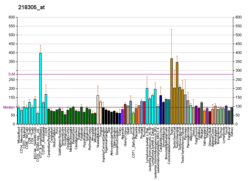IPO4
Importin-4 is a protein that in humans is encoded by the IPO4 gene.[5][6]
References
- 1 2 3 ENSG00000285248 GRCh38: Ensembl release 89: ENSG00000196497, ENSG00000285248 - Ensembl, May 2017
- 1 2 3 GRCm38: Ensembl release 89: ENSMUSG00000002319 - Ensembl, May 2017
- ↑ "Human PubMed Reference:".
- ↑ "Mouse PubMed Reference:".
- ↑ Jakel S, Mingot JM, Schwarzmaier P, Hartmann E, Gorlich D (Feb 2002). "Importins fulfil a dual function as nuclear import receptors and cytoplasmic chaperones for exposed basic domains". EMBO J. 21 (3): 377–86. doi:10.1093/emboj/21.3.377. PMC 125346. PMID 11823430.
- ↑ "Entrez Gene: IPO4 importin 4".
Further reading
- Ewing RM, Chu P, Elisma F, et al. (2007). "Large-scale mapping of human protein–protein interactions by mass spectrometry". Mol. Syst. Biol. 3 (1): 89. doi:10.1038/msb4100134. PMC 1847948. PMID 17353931.
- Beausoleil SA, Villén J, Gerber SA, et al. (2006). "A probability-based approach for high-throughput protein phosphorylation analysis and site localization". Nat. Biotechnol. 24 (10): 1285–92. doi:10.1038/nbt1240. PMID 16964243.
- Miyauchi Y, Michigami T, Sakaguchi N, et al. (2006). "Importin 4 is responsible for ligand-independent nuclear translocation of vitamin D receptor". J. Biol. Chem. 280 (49): 40901–8. doi:10.1074/jbc.M509347200. PMID 16207705.
- Gerhard DS, Wagner L, Feingold EA, et al. (2004). "The Status, Quality, and Expansion of the NIH Full-Length cDNA Project: The Mammalian Gene Collection (MGC)". Genome Res. 14 (10B): 2121–7. doi:10.1101/gr.2596504. PMC 528928. PMID 15489334.
- Ota T, Suzuki Y, Nishikawa T, et al. (2004). "Complete sequencing and characterization of 21,243 full-length human cDNAs". Nat. Genet. 36 (1): 40–5. doi:10.1038/ng1285. PMID 14702039.
- Lischka P, Sorg G, Kann M, et al. (2003). "A Nonconventional Nuclear Localization Signal within the UL84 Protein of Human Cytomegalovirus Mediates Nuclear Import via the Importin α/β Pathway". J. Virol. 77 (6): 3734–48. doi:10.1128/JVI.77.6.3734-3748.2003. PMC 149505. PMID 12610148.
- Strausberg RL, Feingold EA, Grouse LH, et al. (2003). "Generation and initial analysis of more than 15,000 full-length human and mouse cDNA sequences". Proc. Natl. Acad. Sci. U.S.A. 99 (26): 16899–903. doi:10.1073/pnas.242603899. PMC 139241. PMID 12477932.
This article is issued from
Wikipedia.
The text is licensed under Creative Commons - Attribution - Sharealike.
Additional terms may apply for the media files.




